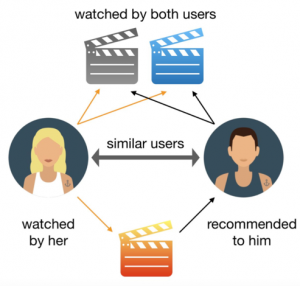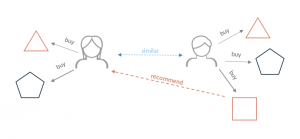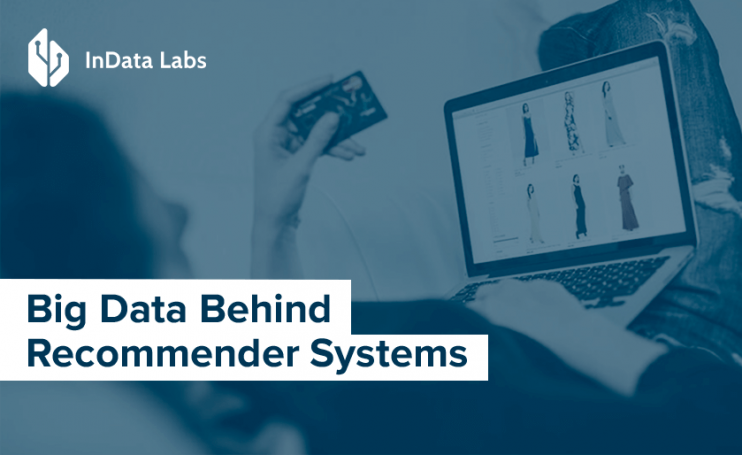Whether you are responsible for customer experience, online strategy, mobile strategy, marketing, or any other customer-impacting part of an organization, you’re already aware of some of the ways recommendation technology is used to personalize content and offers.
What is a recommender system? Based on this technology, machine learning (ML) engineers build recommender systems that redefine the ways customers search for products or services, learn about new opportunities and goods they may be interested in. The driving force behind these systems is big data. There are several types of recommender systems, but all of them work based on voluminous datasets. And big data for the development of custom-made recommender systems may come from multiple sources.
To sort through technical and business aspects of recommender systems, let’s go from a plain definition to types of these systems, the role of big data, and examples of such systems.
What Are Recommender Systems? Types of Recommender Systems?
Recommender systems are one of the most common and easily understandable applications of Big data. There are a lot of examples of recommender systems today. The most known application is probably Amazon’s recommendation engine, which provides users with a personalized web page when they visit Amazon.com.
However, E-commerce companies are not the only ones that use recommendation engines to persuade customers to buy additional products. There are use cases in entertainment, gaming, education, advertising, home decor, and some other industries. Types of recommender systems may vary. And the systems have different applications, from recommending music and events to furniture and dating profiles.
Many worldwide known industry leaders save billions of dollars and engage several times more users be harnessing the power of recommender systems. Hence, Netflix says they save $1 billion each year, and around 75% of content users get through recommendations.

Source: z5.ai
Spotify has increased the number of users thanks to a recommender system that successfully select music out of more than 2 billion playlists and provide recommendations combined as per individual tastes.
There are plenty of other examples of recommender systems that the majority of users, unconsciously or otherwise, deals with almost daily. Let’s go on with what recommender systems are and how you can apply them within your organization.
Types of Data Used by Recommender Systems
Since big data fuels recommendations, the input needed for model training plays a key role. Depending on your business goals, a system can work based on such types of data as content, historical data, or user data involving views, clicks, and likes. The data used for training a model to make recommendations can be split into several categories.
1. User behavior data (historical data)
- Log on-site activity: clicks, searches, page, and item views
- Off-site activities: tracking clicks in emails, in mobile applications, and in their push notifications
2. Particular item details
- Title
- Category
- Price
- Description
- Style
3. Contextual information
- Device used
- Current location
- Referral URL
For you to get a full picture of your customer, it is not enough to be aware of what he or she is viewing on your website and your competitors’ ones. You should take into account the frequency of visits, user location, and types of devices. All the data sources are equally important for the smooth and consistent operation of different types of algorithms.
Owning this information brings you closer to a 29% increase in sales. That is precisely what Amazon experienced firsthand after they had implemented recommendation engines on their website.
But if you want to take content or user features into account, you need to deal with various types of data. That will require a best-fit algorithm, and you will have to solve data-specific tasks. Besides, in case you are launching a new service not having historical data – in other words, in case of cold start – content analysis is everything you have. To make things less complicated, contact us, and our experts into ML and big data will help you.
If you are not sure what type of recommendation engines is suitable for your business, we will make it clear for you right here and now.
Science Behind Recommendations
There are three major types of recommender systems:
- Content-based filtering
- Collaborative filtering
- Hybrid recommender systems
These methods can rely on user behavior data, including activities, preferences, and likes, or can take into account the description of the items that users prefer, or both.
Content-based filtering
This method works based on the properties of the items that each user likes, discovering what else the user may like. It takes into account multiple keywords. Also, a user profile is designed to provide comprehensive information on the items that a user prefers. The system then recommends some similar items that users may also want to purchase.

content-based filtering
Collaborative filtering
Recommendation engines can rely on likes and desires of other users to compute a similarity index between users and recommend items to them accordingly. This type of filtering relies on user opinion instead of machine analysis to accurately recommend complex items, such as movies or music tracks.

collaborative filtering
The collaborative filtering algorithm has some specifics. The system can search for look-alike users, which will be user-user collaborative filtering. So, recommendations will depend on a user profile. But such an approach requires a lot of computational resources and will be hard to implement for large-scale databases.
Another option is item-item collaborative filtering. The system will find similar items and recommend these items to a user on a case-by-case basis. It is a resource-saving approach, and Amazon utilizes it to engage customers and improve sales volumes.
Hybrid recommender systems
It is also possible to combine both types to build a more prosperous recommendation engine. This method is used to generate collaborative and content-based predictions and pull them all together to increase performance.
We have already mentioned Netflix, and this provider of media services uses a hybrid system to win customer loyalty. Users get movie recommendations based on their habits and the characteristics of content they prefer.
Why Should You Integrate Recommender Systems?
Recommender systems have proved themselves efficient in dealing with the following challenges:
- Increase the number of items sold
- Sell more diverse items
- Increase user satisfaction
- Better understand what the user wants
Research by SAS shows that the implementation of a custom recommender system is all about the boost to business value. If a user follows the recommendations and purchases the item, this may lead to the general increase in sales up to 20%. Share on X
Therefore, by providing recommendations, you can give your consumers an option to make customized and informed decisions. A high level of personalization will help you improve customer retention and increase consumer loyalty.
Machine Learning Behind Your Recommender System
At InData Labs, we follow the development pipeline to create and deliver custom recommender systems on time and ensuring the best quality. Our ML engineers work with the latest available tools and technologies to create recommender systems for different purposes. So, popular Python libraries pave the way for project success. Such are Surprise, Implicit, LightFM, and more.
Many businesses may face the cold start problem when they are just on the verge of launching a new service. They are unable to provide engineers with necessary historical data, and there is no user interactions and choices that a computer can analyze. But it is possible to reduce this problem with the help of neural networks that can predict user preferences based on the minimum data.
Examples of Recommendation Engines Put to Work
Recommendation engines are at the front and center of predictive marketing. The key point is that they can be utilized in almost every industry to optimize and improve customer experience.
Personalized product recommendations
Such engines help understand the preferences and intent of each visitor and show the most relevant recommendation type and products in real-time. Recommendations improve as the engine learns more about each visitor.
Website personalization
Allow to Increase sales and conversions by segmenting and targeting visitors with real-time personalized messages and offers.
Real-time notifications
Recommender systems help brands build trust with their customers and create a sense of presence and urgency while showing real-time notifications of shoppers’ activities on the website.
Personalized loyalty programs and offers
A number of studies show that people are more interested in personalized offers than cookie-cutter solutions, which is especially true for loyalty programs. Such engines are able to customize recommendations based on real-time interactions with each customer. Data analytics algorithms are focused on different product categories with different purchase behavior and the integration of contextual information, which improves recommendation quality.
Let InData Labs Work on Recommender System for Your Business
The InData Labs’ team has a vast experience developing custom recommendation engines. Hence, we cooperated with the representative of the entertainment market, providing a premium video-on-demand service. A smart application had 1.5 million monthly active users.
Our team assisted in building a movie recommendation engine and integrating it with the existing technical and business environment. The goals were to optimize sales and attract more users, and a personalized recommender system was the solution.
We opted for a collaborative filtering method, which enabled the system to take into account the opinions and habits of real users. Our ML engineers designed the system to deliver fresh personalized recommendations on a daily basis.
As a result of implementing the recommender system by InData Labs, the business managed to ensure better customer experience by increasing the level of personalization, help customers find movies faster, and improve visitor-to-customer conversion rate.
And that was not the only time InData Labs helped clients drive up business value. To give you more examples, we worked on a health and fitness app, where among our tasks was to use machine learning to design a recommender system.
Our team trained the system to generate personalized recommendations based on user data such as weight gain and loss parameters, gender, body mass index (BMI), and more. The data came from real-time monitoring, user profiles, and GPS, if enabled on user devices.
The engine processes user input and recommends the best fitness plan. Automatically generated recommendations depend on the user’s fitness level. In case personal data suggests that a user easily copes with the current set of activities, the system recommends some more complex exercises. Otherwise, the app can recommend repeating workouts at the current level.
This custom recommender system helped business owners scale up the number of users. And what about your business challenges? InData Labs is on standby to aid you.
So, Let’s Start Cooperation
Schedule an intro consultation with our Machine Learning engineers to explore your business and find out how we can help.
Using machine learning, AI, and big data technologies, InData Labs helps tech startups and enterprises explore new ways of leveraging data, implement highly complex and innovative projects, and build breakthrough AI products. We are waiting for your project ideas!
